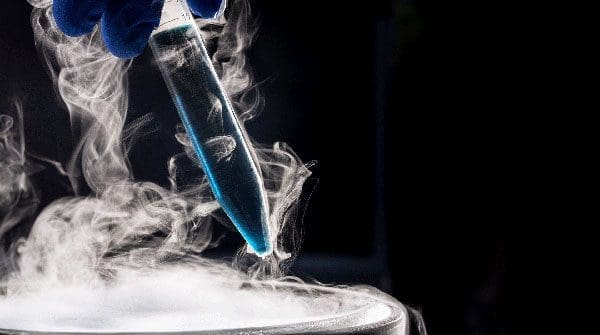Five years ago, the idea of cryopreservation of human organs was science fiction. Not any more
The consensus among Jason Acker’s research associates is that cryogenically preserving human organs for transplantation would be a scientific achievement on par with curing cancer, saving millions of lives each year.
And it may not be that far off, says the professor in the University of Alberta’s Department of Laboratory Medicine and Pathology. Perhaps just five years away. In the meantime, a huge challenge has been freezing cell-based therapies without damaging the living cells.
 Jason Acker |
 Robert Ben |
Acker and University of Ottawa chemistry professor Robert Ben have figured out how to do just that. Through a spinoff company between the two universities, PanTHERA Cryosolutions, they have engineered what’s called ice recrystallization inhibitors – sugar-based molecules that prevent ice from forming around cells. They plan to release their product by the end of the year.
“Cells right now are the new medicines, whether for immune therapies or to treat cancer, and cryopreservation is the only way to store those for a long period of time,” says Acker.
The potential applications for cryopreservation are wide-ranging, he adds, including medical treatments, organ and tissue preservation, reproductive medicine and agriculture.
Biological materials are normally preserved at -196 C – the temperature at which all molecular motion stops – to prevent ice crystals from accumulating around cells. But ice typically forms before cells reach that temperature after harvesting, or when the temperature fluctuates during shipping and whenever a freezer is opened to remove some of the biomaterial.
Think of ice cream left in your household freezer for a year, says Acker. Open the lid and it’s coated with crunchy ice crystals.
PanTHERA has developed families of small, non-toxic synthetic carbohydrates that stop ice accumulation. The researchers aren’t entirely sure why the compounds work as well as they do but suspect they penetrate a “quasi-liquid layer” found on the surface of ice crystals, disrupting the process by which water molecules add to their growth.
The compounds also mean biomaterials can be frozen at much higher temperatures. Since most standard, lab-based freezers cool to about -80 C, cryopreservation becomes more economically feasible.
To help take their new product to market and distribute it globally, PanTHERA has partnered with Biolife Solutions in Seattle, the world’s largest manufacturer of cryopreservation solutions for cell and gene therapy.
Acker and Ben took their inspiration from natural organisms that can survive freezing. Fish, frogs and even trees have evolved to prevent ice from forming in their bodily fluids, says Acker.
“That’s really the key part of our technology – we took the same structures,” he says, adding that his research team screened almost 4,000 synthetic molecules over 10 years for their ability to control ice.
But the roots of Acker’s research go much further back, as far as the U of A’s renowned Edmonton Protocol team and their need to cryopreserve islet cells. The U of A has since become a global centre of excellence for cryopreservation and cryobiology, with researchers across the faculties of medicine, engineering and science exploring new ways of preserving cells, tissues and organs.
There are only two universities, the other in the U.K., that have formal graduate programs in biopreservation at the master’s and PhD levels, says Acker.
“We’re training the next generation of cryobiologists, who are fast becoming a hot commodity. Most of my graduate students are usually recruited into the cell and gene therapy space before they finish their degrees – the need is that desperate.”
For cryobiology and cryopreservation research, there couldn’t be a better time to be in this field, says Acker.
“Five years ago, the idea of freezing an organ was still science fiction. Now with our partners at Massachusetts General Hospital, we have demonstrated partial freezing of liver and lungs from humans and animals.
“It’s not the end goal, but it demonstrates that the technology we’re developing is leading us down that path.”
| By Geoff MacMaster
This article was submitted by the University of Alberta’s Folio online magazine, a Troy Media Editorial Content Provider Partner.
The opinions expressed by our columnists and contributors are theirs alone and do not inherently or expressly reflect the views of our publication.
© Troy Media
Troy Media is an editorial content provider to media outlets and its own hosted community news outlets across Canada.


